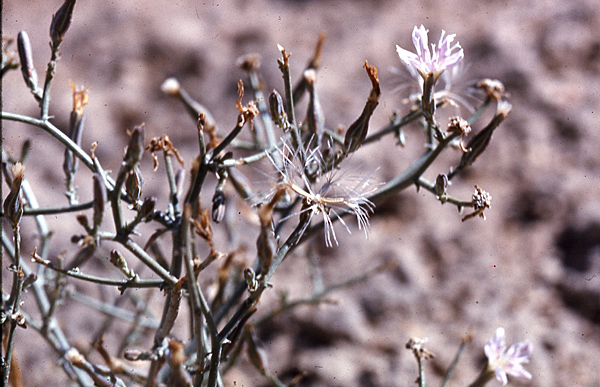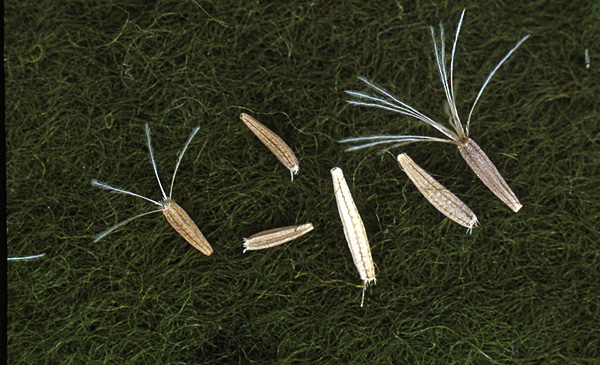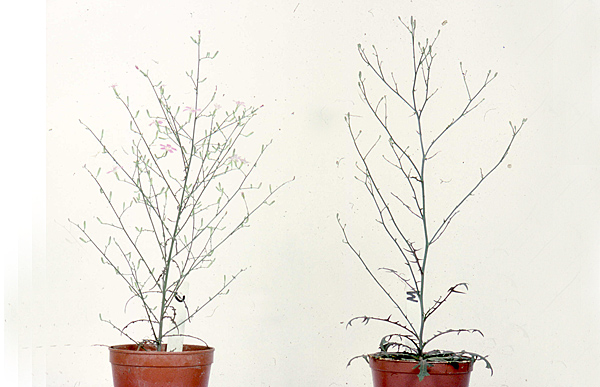Malheur wire-lettuce
Stephanomeria malheurensis (Malheur wire lettuce)
by Les Gottlieb

The two annual plant species Stephanomeria malheurensis (MAL) and S. exigua subsp. coronaria (COR), of the sunflower family (Asteraceae), grow side by side on a hilltop above the glistening remains of Harney Lake south of Burns, Oregon. The sagebrush covered hill, derived from volcanic tuff and surrounded by cracked and pocked basalt, is the only known site for MAL. For COR, it is a northern outpost of a widespread distribution that extends to southern California. MAL is relatively rare on the hilltop, having only two to three percent of the number of plants of COR.
In the high desert of southeastern Oregon, plant number depends on the amount of precipitation during the winter and spring. Census counts in the 1970s showed that in wet years there were as many as 25,000 COR but only a few hundred MAL. In dry years, there were few plants of either species. The fluctuations in their population sizes and their close morphological similarity had the consequence that MAL was very difficult to find. It was not discovered until 1966 and not recognized as a species distinct from COR until 1978. Its rarity and the possibility that the integrity of its single habitat might be threatened by grazing, fire or mining (for zeolites) led to its listing as an endangered species with designated critical habitat by the US Fish & Wildlife Service in 1982

MAL appears to have evolved from a lineage within the local population of COR, probably recently because MAL and COR are very similar and MAL has not been found elsewhere. Few cases are known in which two species display a progenitor-derivative relationship. The situation permits analysis of how an annual plant species originates and how its particular genetic properties differ from those of its parent. The evidence that MAL was distinct came from intensive study of its morphology, pattern of growth and reproductive compatibility with COR.
Seeds from the Harney Lake hilltop were collected in 1966 during the course of a lengthy field trip to study Stephanomeria as part of a doctoral research program. Plants grown out under uniform conditions in a greenhouse were of two types: those that self-pollinated and yielded hundreds of seeds in the total absence of pollinators and others that set no seed without cross-pollination. Seeds from the self-pollinated parents were about 1/3 longer and two times heavier than seeds from the outcrosser. The selfing plants developed larger roots, had fewer, more robust branches and the seed heads were farther apart. They also flowered about 10 to 14 days later than the cross-pollinated plants. The correlation of distinctive architectural traits, reduced seed number and ability to self-pollinate suggested the selfers were genetically different from the outcrossers which had smaller roots, more branches, more seeds and more rapid flowering.


Their reproductive compatibility was tested by crossing them to each other. Pollinations of one type by the other yielded only half as many seeds as pollinations within each type, and the hybrid plants from inter-type crosses showed significantly reduced fertility. Reductions in compatibility and fertility demonstrated that the selfing plants and the outcrossing ones were reproductively isolated, meaning that genes cannot be transferred between them. Thus, they are different species. The outcrossing plants were the widespread S. exigua subsp. coronaria. The selfing plants were named S. malheurensis because they grow near the Malheur Wildlife Refuge and their long-term persistence seemed problematic.
A serious fire burned over the hilltop in 1972 and, following the fire, the aggressive Eurasian weed Bromus tectorum (cheatgrass) invaded the site and caused the decline and local extinction of most of the native herbs including MAL. Fortunately, thousands of seeds of the newly recognized species had been conserved at the University of California, Davis, and at the Berry Botanical Garden in Portland. The stored seed provided an opportunity to re-introduce MAL to its native site. Recently, the Fish & Wildlife Service, which has jurisdiction over endangered and threatened plants and animals, awarded funding for this purpose. The re-introduction will be accomplished by planting out and caring for a thousand or more seedlings grown from the stored seed during each of the next three years. The idea is to establish a seed bank by permitting all the seeds produced to fall into the soil. Once a sufficiently large seed bank can be established, further tinkering will probably not be necessary given that cheatgrass has declined greatly at the site during the past 35 years and may no longer be a serious threat. Seedbanks represent a critical adaptation particularly for annual plant species that grow in the high desert because they maintain species presence at local sites during the many years when precipitation is insufficient for germination and survival to maturity.
MAL is one of the very few, accepted examples of the recent natural origin of a plant species and, given the renewed attention to re-introducing it, hopefully, MAL will also become a conservation success story.
References:
- L. D. Gottlieb. 1991. The Malheur wire-lettuce: a rare, recently evolved Oregon species. Kalmiopsis 1: 9-13.
- US Fish & Wildlife Service. 1982. Determination of Stephanomeria malheurensis (Malheur wildlettuce) to be an endangered species, with determination of critical habitat. Federal Register 47:50881-50886 (pdf)
- Also see: US Fish & Wildlife Service Fact Sheet
